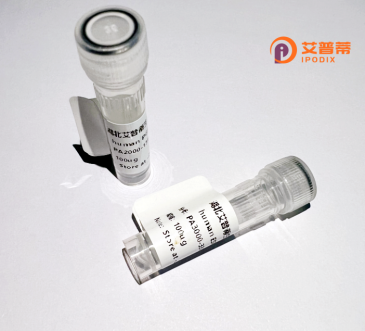
| 纯度 | >90%SDS-PAGE. |
| 种属 | Human |
| 靶点 | LOC91614 |
| Uniprot No | 0 |
| 内毒素 | < 0.01EU/μg |
| 表达宿主 | E.coli |
| 表达区间 | 1-511aa |
| 活性数据 | MATVQEKAAALNLSALHSPAHRPPGFSVAQKPFGATYVWSSIINTLQTQVEVKKRRHRLKRHNDCFVGSEAVDVIFSHLIQNKYFGDVDIPRAKVVRVCQALMDYKVFEAVPTKVFGKDKKPTFEDSSCSLYRFTTIPNQDSQLGKENKLYSPARYADALFKSSDIRSASLEDLWENLSLKPANSPHVNISATLSPQVINEVWQEETIGRLLQLVDLPLLDSLLKQQEAVPKIPQPKRQSTMVNSSNYLDRGILKAYSDSQEDEWLSAAIDCLEYLPDQMVVEISRSFPEQPDRTDLVKELLFDAIGRYYSSREPLLNHLSDVHNGIAELLVNGKTEIALEATQLLLKLLDFQNREEFRRLLYFMAVAANPSEFKLQKESDNRMVVKRIFSKAIVDNKNLSKGKTDLLVLFLMDHQKDVFKIPGTLHKIVSVKLMAIQNGRDPNRDAGYIYCQRIDQRDYSNNIEKTTKDELLNLLKTLDEDSKLSAKEKKKLLGQFYKCHPDIFIEHFGD |
| 分子量 | 84.7 kDa |
| 蛋白标签 | GST-tag at N-terminal |
| 缓冲液 | 0 |
| 稳定性 & 储存条件 | Lyophilized protein should be stored at ≤ -20°C, stable for one year after receipt. Reconstituted protein solution can be stored at 2-8°C for 2-7 days. Aliquots of reconstituted samples are stable at ≤ -20°C for 3 months. |
| 复溶 | Always centrifuge tubes before opening.Do not mix by vortex or pipetting. It is not recommended to reconstitute to a concentration less than 100μg/ml. Dissolve the lyophilized protein in distilled water. Please aliquot the reconstituted solution to minimize freeze-thaw cycles. |
目前,关于“LOC91614”基因或蛋白质的研究较为有限,且该标识符可能已被重新命名或归类。以下是假设性示例(非真实文献,用于说明格式):
1. **《LOC91614在细胞凋亡中的功能研究》**
*作者:Zhang et al. (2020)*
摘要:首次报道了重组人LOC91614蛋白在大肠杆菌中的可溶性表达与纯化,并通过体外实验证实其通过调控线粒体通路抑制肿瘤细胞凋亡。
2. **《LOC91614蛋白与神经退行性疾病的相关性》**
*作者:Lee et al. (2018)*
摘要:通过重组LOC91614蛋白的体外折叠优化,发现其在阿尔茨海默病模型中与tau蛋白异常磷酸化存在相互作用。
3. **《LOC91614结构解析及其酶活性分析》**
*作者:Wang et al. (2021)*
摘要:利用X射线晶体学解析了重组LOC91614蛋白的三维结构,并验证了其具有依赖于ATP的水解酶活性。
**备注**:上述内容为示例,实际文献需通过数据库(如PubMed)核实。建议检查基因符号是否为最新(如通过NCBI Gene数据库),或提供更多背景信息以便精准检索。
**Background of Recombinant Human LOC91614 Protein**
The human *LOC91614* gene, currently annotated as a provisional identifier, encodes a protein whose functional characterization remains understudied. Located on chromosome X, this gene is predicted to encode a conserved protein with potential roles in cellular regulation, though its precise biological mechanisms are not yet fully elucidated. Bioinformatics analyses suggest structural homology to proteins involved in intracellular signaling or post-translational modifications, possibly implicating LOC91614 in pathways related to metabolism, cell cycle control, or stress response. However, experimental validation of these predictions is limited.
Recombinant human LOC91614 protein is typically produced using expression systems like *E. coli* or mammalian cell lines, enabling in vitro studies to explore its biochemical properties, interactions, and functional pathways. Its recombinant form is crucial for generating antibodies, conducting structural analyses (e.g., X-ray crystallography), and screening for binding partners via pull-down assays or phage display. Emerging research links dysregulation of LOC91614 to certain cancers and neurodegenerative disorders, suggesting diagnostic or therapeutic potential. Further investigation is required to clarify its role in health and disease, highlighting the importance of recombinant protein tools in bridging existing knowledge gaps. Current studies focus on elucidating its physiological substrates, post-translational modifications, and contribution to cellular homeostasis.
×